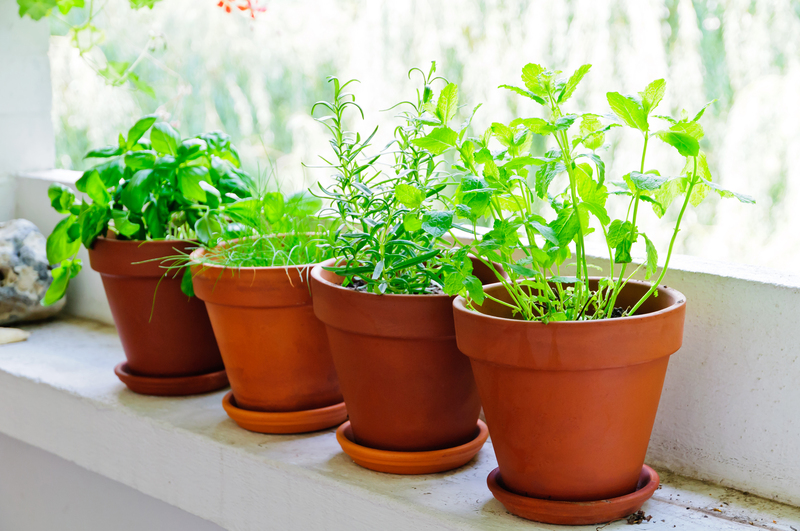Elevate your greenery with vertical gardening
Posted on 22/08/2025
Elevate Your Greenery with Vertical Gardening: A Comprehensive Guide
Vertical gardening has taken the world of horticulture by storm, offering a fresh, innovative approach for those seeking to maximize greenery in limited spaces. Whether you're living in a bustling city apartment or simply want to bring more life into your home or garden, vertical gardens provide a lush, visually striking solution. This article will delve into the benefits, methods, and creative ideas for elevating your plant life through vertical gardening.
What Is Vertical Gardening?
In simple terms, vertical gardening involves growing plants upward rather than outward--the plants are mounted on walls, trellises, or specialized vertical structures. By doing so, homeowners, urbanites, and gardening enthusiasts can elevate their greenery in spaces that might not accommodate traditional gardening beds or large pots.
The concept goes beyond mere aesthetics. Vertical gardens, also known as living walls, green walls, or plant walls, offer practical benefits: improving air quality, reducing energy costs, adding insulation, and providing privacy--all while making a stunning design statement.

Why Choose Vertical Gardening?
- Saves Space: Perfect for small patios, balconies, urban rooftops, and even indoor spaces, vertical gardens allow you to grow more plants in less space.
- Improves Air Quality: Plants are natural air purifiers. Vertical plant walls help filtrate pollutants, creating a healthier indoor or outdoor environment.
- Reduces Energy Costs: When installed on external walls, vertical gardens can help regulate indoor temperatures--lowering cooling costs in summer and providing insulation in winter.
- Enhances Aesthetic Appeal: A lush, green wall becomes a striking feature and a focal point in any home or office.
- Promotes Mental Wellness: Being surrounded by greenery has been linked to reduced stress and increased mental clarity.
Types of Vertical Gardening Techniques
There is a diverse array of methods to elevate your greenery with vertical gardening. Let's explore some of the most popular and effective techniques:
1. Living Walls or Green Walls
This method involves installing a structure on a wall and covering it with a variety of plants, from small ferns to blooming flowers. These living walls can be modular systems with pre-planted panels, or custom-built frameworks that allow for creative plant arrangements.
2. Trellises and Climbing Plants
A time-honored technique for vertical gardening, trellises serve as support for climbing vines like jasmine, clematis, and beans. These can be attached to external walls or used as dividers, creating "green fences" in gardens.
3. Hanging Planters and Pocket Gardens
Wall-mounted hanging planters or fabric pocket panels allow you to grow a variety of plants vertically. Herbs, succulents, and even small houseplants thrive in such setups, making them a favorite for indoor vertical gardening.
4. Vertical Garden Towers
Vertical towers are self-standing structures with multiple planting pockets. Great for patios, balconies, and patios, these vertical towers are ideal for growing a mix of decorative and edible plants.
Choosing the Right Plants for Your Vertical Garden
Selecting the right plants is crucial to elevating your greenery with vertical gardening. Some plants are naturally more suited for vertical growth, while others excel in confined root spaces.
- Ferns - Ferns love moisture and limited sunlight, making them perfect for humid interiors or shaded outdoor walls.
- Succulents - Hardy and drought-tolerant, succulents thrive in pockets and panels. Their minimal soil requirements make them perfect candidates.
- Herbs - Basil, mint, thyme, parsley, and oregano are ideal for kitchen wall gardens, providing both beauty and culinary value.
- Ornamental Grasses - Add movement, texture, and visual interest.
- Flowering Plants - Petunias, pansies, and begonias bring vibrant color to any vertical arrangement.
- Climbing Vines - Morning glory, wisteria, and sweet peas add dramatic height and coverage.
Factors to Consider When Choosing Plants
- Sunlight: Evaluate how much light your wall or space receives during the day.
- Watering Needs: Some vertical gardens dry out quickly, so drought-tolerant plants may be preferable for sunny spots.
- Growth Habits: Choose plants whose natural tendencies suit vertical arrangements.
How to Create Your Own Vertical Garden
Ready to elevate your greenery with a vertical garden at home? Here's a step-by-step guide for beginners and enthusiasts alike:
Step 1: Choose Your Location
Assess your available space for vertical gardening. Common locations include:
- Balcony or patio walls
- Kitchen backsplashes
- Outdoor fences or boundaries
- Living room feature walls
Step 2: Select Your Vertical Garden System
Options range from DIY wooden trellises, pre-made wall pockets, or elaborate modular systems. Consider your budget, available tools, and design preferences.
Step 3: Prepare the Wall or Structure
Ensure your wall can support the weight of soil, water, and plants. If indoors, use a waterproof barrier to protect your surfaces.
Step 4: Install the Support System
Mount your planting panels, frames, or containers securely, following manufacturer instructions for stability and safety.
Step 5: Add Soil and Plants
Choose a lightweight, nutrient-rich soil mix. Position plants according to their light and water needs: shade-lovers towards the bottom, sun-lovers at the top.
Step 6: Water, Maintain, and Enjoy
Establish a watering routine, as vertical gardens may dry out faster than traditional beds. Prune regularly for shape and health, and enjoy your elevated greenery!
Design Inspirations: Creative Ideas for Vertical Gardening
Vertical gardening is as much about creativity as it is about functionality. Here are some inspiring ways to elevate your greenery with vertical gardening:
- Herb Walls: Ideal for kitchens--install a set of wall-mounted planters and fill them with your favorite cooking herbs.
- Flower Art Panels: Arrange colorful flowering plants into living murals on exterior or interior walls.
- Upcycled Pallet Gardens: Convert old wooden pallets into multi-tiered gardening displays for succulents or annuals.
- DIY Bottle Gardens: Repurpose plastic bottles as hanging containers for small plants on fences or balconies.
- Freestanding Garden Towers: Use vertical towers to grow strawberries, lettuce, and other edibles on patios with minimal space.
- Green Privacy Screens: Use tall vertical gardens as living fences to separate outdoor spaces or provide privacy from neighbors.
Common Challenges and How to Overcome Them
While vertical gardening is exciting, it comes with its own set of challenges. Here's how to tackle them:
- Watering Issues: Vertical gardens often dry out faster. Drip irrigation systems or self-watering planters can help keep plants hydrated without overwatering.
- Structural Concerns: Not all walls are built to hold the weight of a full living wall. Always ensure mounting systems are secure and seek professional advice for large installations.
- Pest Problems: Since plant density is higher, monitor regularly for insects or fungal diseases. Use organic pest control whenever possible.
- Light Access: Plants at the bottom may receive less light. Rotate plants or arrange them according to their light requirements.
Sustainability: Eco-Friendly Benefits of Vertical Gardening
Elevating your greenery with vertical gardening practices is more than an aesthetic pursuit--it's a commitment to sustainability. Vertical gardens contribute to environmental well-being by:
- Improving Urban Air Quality: Green walls help absorb CO2 and other pollutants, mitigating urban heat islands.
- Supporting Biodiversity: Diverse plantings attract pollinators and beneficial insects, supporting local ecosystems.
- Insulation and Energy Savings: Vertical green walls act as natural insulation for buildings, reducing the need for artificial cooling and heating.
- Reducing Food Miles: Grow your own herbs, greens, and even vegetables close to home, cutting down on transportation and packaging.
Tools and Materials for Vertical Gardening Success
To get started, you'll need a few essential tools and materials:
- Mounting Hardware: Brackets, bolts, hooks for securing frames or systems to walls.
- Growing Medium: Lightweight potting mix, coconut coir, or specialized soil blends.
- Containers or Panels: Planters, pockets, trellises, or vertical towers, depending on your chosen design.
- Watering System: Watering can, spray bottle, or automated drip irrigation.
- Fertilizers: Slow-release or liquid plant foods suited for your plant types.

Maintaining Your Vertical Garden Long-Term
Once established, a vertical garden requires ongoing care to stay healthy and vibrant. Here are key maintenance tips:
- Monitor Watering Needs: Check soil moisture regularly, especially during hot months or for indoor setups.
- Feed Your Plants: Use appropriate fertilizers to replenish nutrients lost through regular watering.
- Prune Promptly: Remove dead leaves, trim overgrowth, and maintain shape for optimal aesthetics and plant health.
- Inspect for Pests: Treat infestations early using organic or targeted solutions.
- Rotate and Refresh: Consider rotating plants seasonally or replanting pockets for variety and vigor.
Conclusion: Elevate Your Greenery Today
Whether you're a seasoned gardener or a curious beginner, vertical gardening offers endless opportunities to elevate your greenery and enrich your environment. By harnessing the vertical space in your home or garden, you unlock new potential for beauty, sustainability, and well-being. So gather your tools, pick your favorite plants, and start crafting your own living wall or tower today--your space (and the planet) will thank you!
Remember, the sky's the limit when it comes to vertical gardening--get creative, experiment with new techniques, and watch your living wall flourish. For even more tips and inspiration on elevating your greenery with vertical gardening, follow expert blogs, join gardening communities, and explore innovative designs that fit your lifestyle.

